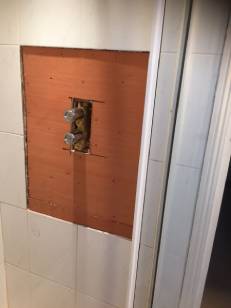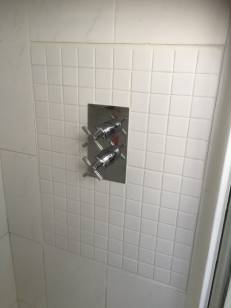Replacing a Shower When Tiles Can’t Match [Project]
Replacing a shower is one of the most common bathroom renovation projects. Whether you are dealing with a leaking shower unit, cracked tiles, faulty plumbing, or you simply want to upgrade to a modern design, understanding the process is essential. This guide covers everything you need to know about shower replacement, from DIY methods and professional installation to costs, tools, and common mistakes.
The director of the Bathroom and Boiler division of My Plumber shares his secret to replacing a shower when the tiles can’t be matched. This project is a huge money saver for clients who don’t want to spend money replacing all the tiles in the bathroom. There are a few plumbers who would tell you that!
How to Replace a Shower Unit
Replacing a shower unit can be done as a DIY project or by hiring a professional plumber. The steps generally include:
- Turn off water supply before starting.
- Remove the old shower unit, including the shower head, hose, riser rail, and valve.
- Inspect plumbing connections for leaks or damage.
- Install the new shower unit, ensuring correct fitting of pipes and controls.
- Seal joints with waterproof silicone to prevent leaks.
- Test water flow and pressure before use.
For electric shower replacement, additional steps include safely disconnecting wiring. Always seek a qualified electrician for wiring work.
How to Replace a Shower When the Tiles Can’t Match
1. Remove the faulty shower and the surrounding tiles

2. Prepare the area for tiling

3. Fit the new shower unit
4. Fit mosaic tiles onto the prepared surface

Can You Replace a Shower Without Removing Tiles?
Yes, in some cases you can replace a shower unit or head without disturbing tiles. However:
- If the leak is caused by hairline cracks in grout or deteriorated sealant, tiles may need regrouting or resealing.
- Shower valves behind tiled walls may require access panels.
- For shower tray replacement, tiles around the base often need to be removed.
If your tiles are intact, a straightforward shower unit swap can be achieved with minimal disruption.
How Much Does It Cost to Replace a Shower?
Costs vary depending on the type of replacement and whether you hire a professional:
- Basic shower head replacement – £50–£120.
- Replacing a shower unit – £200–£500 including labour.
- Electric shower replacement – £250–£600 (with wiring check).
- Full shower enclosure replacement – £500–£1,000.
- Bathroom renovation with shower replacement – £1,500+.
Labour charges for plumbers in the UK range from £50–£90 per hour, with additional costs for materials.
Replacing a Shower Tray and Enclosure
A leaking or cracked shower tray often requires full replacement:
- Remove the shower enclosure panels and old tray.
- Inspect the waste pipe and drain cover for clogs or damage.
- Fit the new tray with correct levelling.
- Seal edges with waterproof silicone.
- Reinstall enclosure panels and shower screen.
This process may also involve replacing grout and tiles if water damage is present.
Common Mistakes When Replacing Showers
- Failing to reseal grout or silicone after replacement.
- Installing a new unit on top of damaged waterproofing.
- Ignoring water pressure issues when upgrading to a modern shower.
- Incorrectly fitted shower trays leading to future leaks.
- Using the wrong type of sealant for wet areas.
Is It Difficult to Retile a Shower?
Retiling a shower is not the most straightforward DIY project, but it is possible with patience, the right tools, and attention to detail. The level of difficulty depends on your experience and the condition of the existing shower. Factors that make retiling challenging:
- Tile removal – Old tiles, grout, and adhesive must be removed carefully to avoid damaging the waterproofing or backing boards.
- Surface preparation – Walls must be smooth, clean, and properly waterproofed before new tiles are applied.
- Tile cutting – Precision is required for edges, corners, and around fixtures such as shower valves and pipes.
- Waterproofing – Failing to correctly seal joints and grout can cause leaks and long-term water damage.
- Time and effort – Retiling a shower is labour-intensive and messy, often taking several days including drying times.
Suitable for DIY or Professional Help?
DIY retiling may be manageable for someone with tiling experience, especially for small areas. Professional tilers are recommended if:
- The existing tiles are heavily damaged.
- Waterproofing membranes need replacement.
- You want a flawless finish with minimal risk of leaks.
Takeaways
You have just saved yourself a fortune. Some plumbers would have told you that the whole area needed to be re-tiled. This is just another way that My Plumber can save you money. Feel free to contact us for any shower or bathroom repairs. We can fix any leaking and dripping showers or taps.
Replacing a Shower When Tiles Can’t Match [Project]
Need help? Hire the London Property Service experts today by giving us a call on 020 3078 5920.




